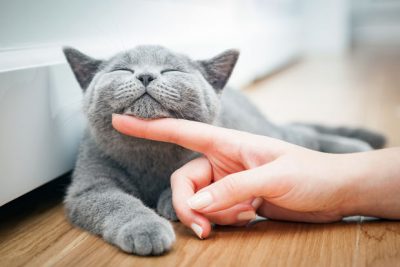Have you ever been grabbed for a well meant cuddle when you just weren’t in the mood? Imagine how your cat feels.
Being picked up and hugged can be a stressful for cats. Cats are skilled predators, but they’re also prey animals and being restrained can feel threatening. Next time you’re hankering to cuddle your cat, think about how they might feel about it. Cats are naturally cautious, and they like to keep all four paws on a solid surface, in case they need to leap away.
Understanding this is key to living happily with a cat. In fact, the more you let your cat decide when, where, and how affection will happen, the more they’ll trust you and enjoy the interaction. Cats are more likely to approach us for affection, and to hang around longer, when we let them make the first move.
“Ask” First
Like us, cats prefer that we ask if it’s okay before we touch. Felines who are friends greet each other by touching noses. A human head is too big and potentially intimidating to offer. Try gently offering a fingertip at their nose level, a few inches away, as a way to ask politely, “May I pet you?”

Some cats will say no by walking away. Some may approach but then sit down with a bit of space between you. This is their way of saying, “I’m fine over here, but no touching yet.” No matter how adorable the cat, we need to respect those limits. Many cats will walk up and sniff your finger, and may even rub into it. That’s the invitation for petting.
Watch And Learn
Where you pet a cat matters a great deal to them. If you were visiting a country with a totally unfamiliar culture, you’d watch where and how the people touch each other to figure out what is and is not considered polite. When watching a friendly feline greeting, we find that they lick and touch each other around the cheeks, forehead, back of the neck, and shoulders. They always follow the grain of the fur in friendly interactions. There’s no rubbing the fur up the wrong way.
A couple of studies have found that cats showed more positive responses to their humans, such as purring, blinking, and kneading their paws, when they were petted on the forehead area and the cheeks. Respect and follow this feline etiquette.
What about that spot at the base of the tail, the one that causes some cats to lift their butt in the air? The petting studies suggest that’s actually not a favourite spot for many cats. Cats who do like it show you very clearly by lifting their behind. If your cat is not raising his butt for more, he’s one of the many who don’t care for that sort of thing.
Even when a cat says okay to touch, we’ve all had that experience where we’re petting a cat and it’s bliss, bliss, bliss—and then suddenly swat! It seems like it all changed in a nanosecond. Cats do have issues when it comes to being touched, and they get overloaded pretty quickly. But not as quickly as we might think. That swat is usually preceded by more subtle signals that we have missed.
How a cat communicates that they have had enough varies for each individual. Signs of over stimulation include the following:
- Skin over the shoulders stiffens or ripples
- Whiskers come forward
- Ears flick back, sideways, or flat
- Tail flicks or lashes
- Skin twitches
- Pupils dilate
- Claws come out
- A paw is raised
- Vocalization (other than purring)
If you see any one of those signs, stop petting. If your cat chooses to remain beside you (because you have been so polite), wait a few minutes before you start petting again or better still, just keep your hands to yourself until they seek affection in their own time.

Of course, every cat is an individual with his own preferences. The best way to pet your cat is just the way they like it. Pay close attention to your cat’s body language, observe the feline rules of politeness, and you’ll both be enjoying more cuddle time.
